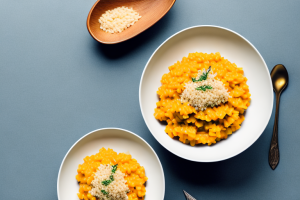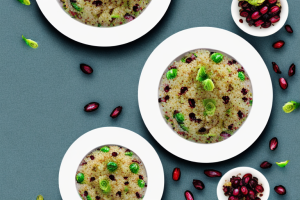How to steam sushi rice with spicy shrimp
8 min read
A bowl of steamed sushi rice topped with spicy shrimp
Japanese cuisine is highly regarded for its delicate balance of flavors, textures and presentation. One of the most celebrated dishes in Japanese cuisine is sushi, which is revered worldwide. Sushi is a dish that is incredibly versatile and can be adapted to suit individual tastes and preferences. One of the most popular variations of sushi is spicy shrimp sushi. This dish has a wonderful flavor, and it is also quite easy to prepare. In this article, we will provide a step-by-step guide on how to steam sushi rice with spicy shrimp.
Preparing the sushi rice
The first step towards making delicious sushi with spicy shrimp is preparing the rice. It would be best if you got the rice preparation right because the rice is the foundation on which all sushi is built. We recommend using short-grain rice because it is sticky and easier to work with. Before you start cooking, rinse the rice, and mix it gently in a bowl of cold water two or three times while discarding the water. Continue rubbing the rice gently with your fingertips until the water is clear.
After rinsing the rice, let it soak in cold water for about 30 minutes. This will help the rice absorb water and cook evenly. Once the rice has soaked, drain the water and add the rice to a pot with the appropriate amount of water. Bring the water to a boil, then reduce the heat to low and cover the pot. Cook the rice for about 18-20 minutes, or until all the water has been absorbed.
Once the rice is cooked, transfer it to a large bowl and add sushi vinegar. Use a wooden spoon or spatula to mix the rice and vinegar gently. Be careful not to overmix, as this can cause the rice to become mushy. Allow the rice to cool to room temperature before using it to make sushi with spicy shrimp.
Choosing the right type of rice for sushi
Short-grain rice is the best type of rice to use to prepare sushi. This type of rice is plump, sticky, and has a soft, tender texture. It is essential when preparing sushi because it holds together well and doesn’t fall apart when rolled.
When selecting short-grain rice for sushi, it is important to choose a high-quality variety. Look for rice that is labeled as sushi rice or Japanese rice. These types of rice have the perfect balance of starch and moisture content, which is crucial for achieving the right texture and flavor in your sushi.
Another important factor to consider when choosing rice for sushi is the washing and soaking process. It is recommended to wash the rice several times until the water runs clear, and then soak it for at least 30 minutes before cooking. This helps to remove excess starch and ensures that the rice cooks evenly and has the right texture for sushi.
Cleaning and washing the rice
Before cooking the rice, it is essential to rinse it thoroughly. Place the rice in a bowl and fill it with cold water. Use your hands to stir the rice gently, and pour out the water. Repeat the process until the water runs clear.
It is important to note that different types of rice may require different amounts of water for cooking. For example, brown rice typically requires more water and a longer cooking time than white rice. It is also recommended to let the rice soak in water for at least 30 minutes before cooking, as this can help to improve its texture and flavor.
Measuring the rice and water
The traditional ratio of sushi rice to water is one to one. However, it would be best to follow the instructions on the packaging of your rice to prepare it correctly. The amount of water needed varies depending on the brand and variety of rice you’re using.
It’s important to note that the type of pot you use can also affect the amount of water needed. A heavy-bottomed pot with a tight-fitting lid will require less water than a thinner pot with a loose lid. Additionally, the altitude at which you are cooking can also impact the amount of water needed. At higher altitudes, you may need to add more water to compensate for the lower boiling point of water.
Adding seasoning to the rice
Before cooking the rice, add sushi seasoning or a mixture of rice vinegar, sugar, and salt. Sushi seasoning is a blend of rice vinegar, sugar, and salt that is designed specifically for sushi rice and can be added to the rice immediately after it finishes cooking.
Adding seasoning to the rice not only enhances the flavor but also helps to preserve the rice. The vinegar in the seasoning mixture acts as a natural preservative, preventing the growth of harmful bacteria and extending the shelf life of the rice. Additionally, the sugar in the seasoning mixture helps to give the rice a glossy appearance, making it more visually appealing when served.
Cooking the rice in a pot or rice cooker
The method of cooking rice can vary depending on the preference of the chef. Some sushi chefs use a pot to cook their sushi rice, while others prefer to use a rice cooker. If using a pot, heat the rice and water until it boils on high heat, then reduce the heat to low and let it simmer for 20 minutes. When using a rice cooker, follow the instructions provided.
It is important to note that the quality of the rice can also affect the cooking process. Sushi rice should be rinsed thoroughly before cooking to remove excess starch and ensure a fluffy texture. Additionally, using high-quality rice vinegar and sugar in the seasoning mixture can greatly enhance the flavor of the sushi rice. Experimenting with different types of rice and seasoning ratios can lead to unique and delicious sushi creations.
Preparing the spicy shrimp filling
The next step is preparing the spicy shrimp filling. Here are the steps:
First, you will need to clean and devein the shrimp. This can be done by removing the shell and the black vein that runs along the back of the shrimp. Once cleaned, chop the shrimp into small pieces.
Next, heat a pan over medium heat and add some oil. Once the oil is hot, add chopped garlic and sauté for a minute. Then, add the chopped shrimp and cook until they turn pink. Add salt, red chili powder, and cumin powder to taste. Mix well and cook for another minute. Your spicy shrimp filling is now ready to be used in your recipe.
Choosing fresh shrimp for sushi
When preparing spicy shrimp sushi, it is essential to choose fresh shrimp. Avoid shrimp that has a fishy smell or appears to be slimy or discolored. Fresh shrimp will taste sweet and have a slightly translucent appearance.
Another important factor to consider when choosing fresh shrimp for sushi is the source. Look for shrimp that has been sustainably farmed or caught, as this ensures that the shrimp has been raised or caught in an environmentally responsible way. Additionally, choosing shrimp that has been certified by a reputable organization, such as the Marine Stewardship Council, can give you peace of mind that the shrimp has been responsibly sourced.
Cleaning and deveining the shrimp
Clean the shrimp by rinsing under cold running water and removing the shells. Use a sharp knife to make a shallow incision along the back of the shrimp and remove the vein. Wash the shrimp under cold running water again and pat dry with paper towels.
It is important to note that deveining the shrimp not only improves the appearance of the dish, but also removes any potential digestive tract that may contain sand or grit. This step is especially important if the shrimp will be served whole or with the tails on. Once the shrimp are cleaned and deveined, they are ready to be cooked and enjoyed in a variety of dishes.
Marinating the shrimp in spices and sauces
Now it’s time to marinate the shrimp. Coat the shrimp with a mix of spices and sauces that you prefer, such as soy sauce, chili sauce, garlic, and ginger. Place the shrimp in the refrigerator for at least 1 hour to marinate.
Marinating the shrimp not only adds flavor but also helps to tenderize the meat. The acid in the sauces and spices breaks down the protein in the shrimp, making it more tender and juicy. However, be careful not to marinate the shrimp for too long, as the acid can also over-tenderize the meat and turn it mushy. One hour is usually enough time for the shrimp to absorb the flavors and become tender.
Cooking the shrimp in a pan or on a grill
Cook the shrimp until it turns pink. You can use a pan or grill. It is essential to avoid overcooking the shrimp or they will become rubbery.
When cooking shrimp in a pan, it is recommended to use a non-stick pan or to add a small amount of oil to prevent sticking. You can also add some garlic and butter to the pan for extra flavor.
If you are grilling the shrimp, it is best to skewer them to prevent them from falling through the grates. You can also marinate the shrimp in a mixture of olive oil, lemon juice, and herbs before grilling to add more flavor.
Assembling the sushi rolls with spicy shrimp filling
The next step is to assemble the sushi rolls with the spicy shrimp filling. Here’s how:
Preparing a bamboo rolling mat for making sushi rolls
You will need to use a bamboo rolling mat. To prevent the sushi rice from sticking to the mat, wrap the mat with cling film.
Spreading the rice on the nori sheet
Place the nori sheet on the bamboo mat with the shiny side facing down. Wet your hands with water, and take a small handful of rice, placing it evenly on the nori sheet. Carefully press the rice down on the nori sheet, making sure it is evenly distributed.
Placing the spicy shrimp filling on top of the rice
Arrange the cooked spicy shrimp along the center of the rice. Try to distribute the shrimp evenly so that every roll will have an equal amount of filling.
Rolling and shaping the sushi rolls
Using the bamboo mat, carefully roll the sushi, making sure to tuck the filling firmly into the rice. Slowly and gently press the bamboo roll to give it an even shape. Slice the rolls into bite-sized pieces, and place them on a platter.
Cutting the sushi rolls into bite-sized pieces
To cut the sushi, use a sharp, wet knife. Wetting the knife before use will prevent the sushi rice from sticking. Slice the sushi rolls into bite-sized pieces.
Serving and garnishing options for sushi with spicy shrimp
Now that you have successfully prepared your sushi with spicy shrimp, it’s time to add some finishing touches. Here are some ideas for serving and garnishing your sushi:
Pairing sake or other drinks with your sushi meal
Sake is a traditional Japanese drink that pairs well with sushi. However, if you don’t like sake, you can enjoy your sushi with a glass of white wine, green tea, or a refreshing beverage of your choice.
In conclusion, sushi with spicy shrimp is a tasty and accessible dish that you can quickly prepare at home. By following our step-by-step guide, you can have a delicious meal ready in no time. Remember to use high-quality ingredients and take your time to get the most out of this exquisite recipe. Happy cooking!


